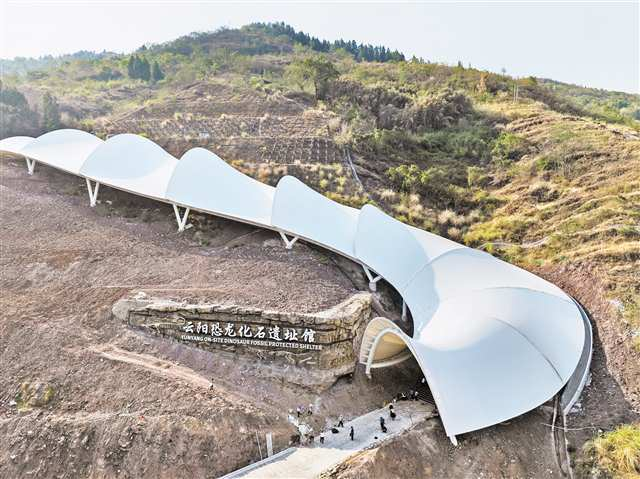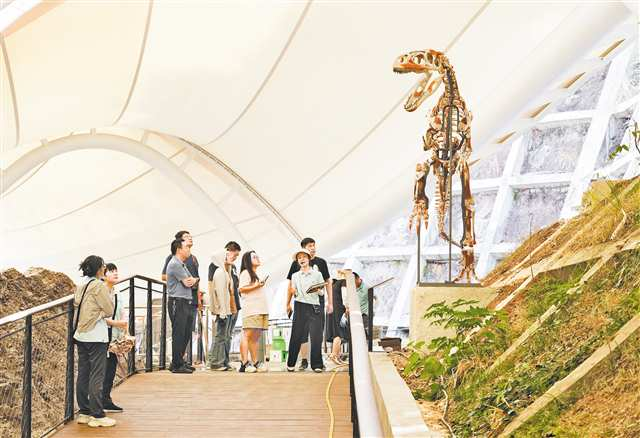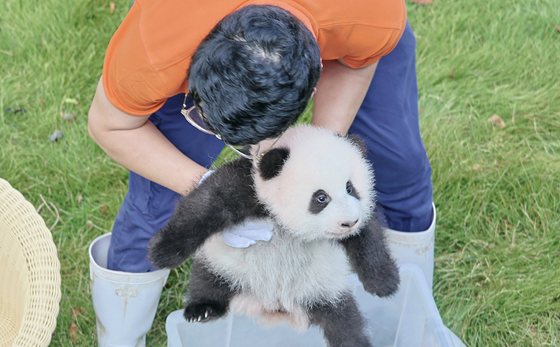Opening of the Dinosaur Fossil Site Museum at Yunyang Geopark
2024-09-30 14:23:57


CHONGQING (CQNEWS) -- The Dinosaur Fossil Site Museum at Yunyang Geopark officially opened its doors to the public on September 28, offering visitors a close encounter with Jurassic fossils that date back hundreds of millions of years on the awe-inspiring "Great Wall of Dinosaur Fossils".
Located in Pu'an Township, Yunyang, the museum discovered the first dinosaur fossils in the region in 2014, with formal excavation efforts beginning in 2016. Over time, researchers uncovered a 150-meter-long and 6-to-10-meter-high fossil wall, which was buried at least 20 meters deep, making it the largest single in-situ Jurassic fossil site in the world. This breathtaking find has earned the fossil wall reputation as the Great Wall of Dinosaur Fossils among paleontologists.
The fossil wall contains nearly 5,000 dinosaur bones, representing various skeletal parts such as skulls, teeth, vertebrae, and limb and pelvic bones. So far, five distinct types of dinosaur fossils have been identified, including those of sauropods, theropods, ornithopods, stegosaurs, and basal neornithischians.
In a significant contribution to paleontology, researchers have already named five new species of dinosaurs discovered at this site: Pu'an Yunyangosaurus puanensis, Sanxiaosaurus modaoensis, Omeisaurus puxiani, Bashanosaurus primitivus, and Yuzhoulong qurenensis. The Yunyang dinosaur fauna spans the entire Middle Jurassic, making it a quintessential representative of Jurassic dinosaur fossils in Chongqing. Yunyang is one of the most densely fossil-rich sites in Chongqing, characterized by a wide temporal range, extensive and concentrated distribution, and a wide variety of dinosaur species, bridging the gap in our understanding of early to middle Jurassic evolution.
But why were so many dinosaur fossils found in Pu'an Township? Leading paleontologists suggest that, between 180 and 160 million years ago, the area was once a lakeside environment at the edge of the ancient Bashu Lake. Numerous dinosaur species thrived here. However, catastrophic events such as mudslides, floods, or torrential rainstorms may have wiped out entire herds. These dinosaur remains were subsequently transported by rivers into the lake’s delta, where they were buried and preserved as fossils over time.
Extended Reading >>>
The "stone" that turned out to be a dinosaur fossil
"I thought I had picked up a pig bone or some other animal bone. I never imagined it would be a dinosaur fossil," recalled Zhou Zheng, a resident of Qingshui Tujia Township in Yunyang County. On September 27, he shared the story of his unexpected discovery in Laojun Village back in 2014.
At the time, Zhou, then 18, had come to Laojun Village in Pu'an Township with a construction team to help build homes for local villagers. One day, as the rainy season blurred the line between summer and autumn, the team paused work due to morning showers. Zhou took the opportunity to assist with herding cattle in the nearby hills.
"While herding, a puppy was following me, so I casually picked up a ‘stone’ and pretended to throw at it," Zhou recounted. The "stone" resembled a large pig bone or another animal bone, but it was much denser and heavier than anything he’d seen before. Scattered around were several other "stones" of varying sizes. "I began to wonder if this might be the fossil of some ancient animal."
Zhou showed the "stone" to a few local villagers, but they dismissed it as the bone of a common wild animal. Still intrigued, Zhou was reminded of the dinosaurs he had seen in movies. "I contacted the county museum to have the stone identified," he said. About a month later, the museum confirmed the astonishing truth – the "stone" was indeed a dinosaur fossil.
This marked the beginning of the gradual unveiling of a rare and mysterious dinosaur fossil site... (Translated by Yuki, Fathom Language Limited)
Editor:江夷玮

 手机阅读分享话题
手机阅读分享话题